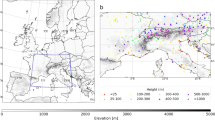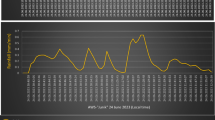Abstract
In this study, an attempt is made to simulate super typhoon Maysak, which occurred over the northwest Pacific Ocean in 2015 and made landfall on the Philippines coast. The aim of the present study is to assess the various atmospheric conditions during the life cycle of Maysak to explore the associated dynamics and behavior over the ocean. For this purpose, the advanced research core of the weather research and forecasting (WRF) mesoscale model is adopted. The model is simulated using 27-km horizontal grid resolution with National Centers for Environmental Prediction global Final analyses (FNL) initial conditions. The relevant parameters, namely storm track, intensity, wind–vorticity, rainfall, minimum sea level pressure, relative humidity, and maximum reflectivity etc., were analyzed. The model is able to perform reasonably well when available observations over the region compared with the simulated values of these parameters. The present study is able to demonstrate the capability of WRF in simulating and predicting the relevant characteristic features of typhoons over the northwest Pacific Ocean region through the case of Maysak.












Similar content being viewed by others
References
Anthes RA, Chang SW (1978) Response of the hurricane boundary layer to changes of sea surface tempera-ture in a numerical model. J Atmos Sci 35:1240–1255
Braun SA, Tao WK (2000) Sensitivity of high-resolution simulations of Hurricane Bob (1991) to planetary boundary layer parameterizations. Mon Weather Rev 128:3941–3961
Carvalho D, Rocha A, Gomez-Gesteira M, Santos C (2012) A sensitivity study of the WRF model in wind simulation for an area of high wind energy. Environ Model Softw 33:23–34
Chandrasekar R, Balaji C (2012) Sensitivity of tropical cyclone Jal simulations to physics parameterizations. J Earth Syst Sci 121:923–946
Das MK, Chowdhury Md AM, Das S (2015) Sensitivity study with physical parameterization schemes for simulation of mesoscale convective systems associated with squall events. Int J Earth Atmos Sci 2:20–36
Dasari HP, Brahmananda RV, Ramakrishna SSVS, Paparao G, Nanaji RN, Ramesh KP (2017) On the movement of tropical cyclone LEHAR. Earth Syst Environ 1:1–14
DeMaria M, Knaff JA, Sampson C (2007) Evaluation of long-term trends in tropical cyclone intensity forecasts. Meteorol Atmos Phys 97:19–28
Dudhia J (1989) Numerical study of convection observed during winter monsoon experiment using a mesoscale two-dimensional model. J Atmos Sci 46:3077–3107
Emanuel K (2005) Increasing destructiveness of tropical cyclones over the past 30 years. Nature 436:636–638
Gabriel A, Vecchi BJS (2007) Effect of remote sea surface temperature change on tropical cyclone potential intensity. Nature 450:1066–1070
Haghroosta T, Ismail WR, Ghafarian P, Barekati SM (2014) The efficiency of the weather research and forecasting (WRF) model for simulating typhoons. Nat Hazards Earth Syst Sci 14:2179–2187
Hong SY, Noh Y, Dudhia J (2006) A new vertical diffusion package with explicit treatment of entrainment processes. Mon Weather Rev 134:2318–2341
Houze RA et al (2006) The Hurricane Rainband and intensity change experiment: observations and modeling of Hurricanes Katrina, Ophelia, and Rita. Bull Am Meteorol Soc 87:1503–1521
Igri PM, Tanessong RS, Vondou DA, Mkankam FK, Panda J (2015) Added-value of 3DVAR data assimilation in the Simulation of heavy rainfall events over Western and Central Africa. Pure Appl Geophys 172:2751–2776
Igri PM, Tanessong RS, Vondou DA, Panda J, Garba A, Mkankam FK, Kamga A (2018) Assessing the performance of WRF model in predicting high-impact weather conditions over central and western Africa: an ensemble-based approach. Nat Haz 93:1565–1587
Jiang H, Zipser EJ (2010) Contribution of tropical cyclones to the global precipitation from eight seasons of TRMM data: regional, seasonal, and interannual variations. J Clim 23:1526–1543
Kain JS (2004) The Kain-Fritsch convective parameterization: an update. J Appl Meteorol 43:170–181
Kain JS, Fritsch JM (1993) Convective parameterization for mesoscale models: the Kain-Fritcsh scheme. In: Emanuel KA, Raymond DJ (eds) The representation of cumulus convection in numerical models. American Meteorological Society, p 246
Kossin JP, Eastin MD (2001) Two distinct regimes in the kinematics and thermodynamic structure of the hurricane eye and eyewall. J Atmos Sci 58:1079–1090
Kumar S, Chauhan R, Routray A, Panda J (2014) Impact of parameterization schemes and 3DVAR data assimilation for simulation of heavy rainfall events along west coast of India with WRF modeling system. Int J Earth Atmos Sci 01:18–34
Li X, Pu Z (2008) Sensitivity of numerical simulation of early rapid intensification of hurricane Emily (2005) to cloud microphysical and planetary boundary layer parameterization. Mon Weather Rev 136:4819–4838
Liu Y, Zhang DL, Yau MK (1997) A multiscale numerical study of Hurricane Andrew (1992). Part I: explicit simulation and verification. Mon Weather Rev 125:3073–3093
Maw KW, Towfiqul IARM, Sein ZMM, Jinzhong M, Argete JC (2017) Simulation of storm surge in Myanmar Coast. Earth Syst Environ 1:1–12
Mlawer EJ, Taubman SJ, Brown PD, Iacono MJ, Clough SA (1997) Radiative transfer for inhomogeneous atmosphere: RRTM, a validated correlated-k model for the longwave. J Geophys Res 102(D14):16663–16682
Nguyen VH, Chen YL (2011) High-resolution initialization and simulations of typhoon morakot (2009). Mon Weather Rev 139:1463–1491
Panda J, Giri RK, Patel KH, Sharma AK, Sharma RK (2011) Impact of satellite derived winds and cumulus physics during the occurrence of the tropical cyclone Phyan. Indian J Sci Technol 04:859–875
Panda J, Singh H, Wang PK, Giri RK, Routray A (2015) A qualitative study of some meteorological features during tropical cyclone PHET using satellite observations and WRF modeling system. J Indian Soc Rem Sens 43:45–56
Pattanaik DR, Rao YVR (2009) Track prediction of very severe cyclone ‘Nargis’ using high resolution weather research forecasting (WRF) model. J Earth Syst Sci 118:309
Rappaport EN (2000) Loss of life in the United States associated with recent Atlantic Tropical cyclones. Bull Am Meteorol Soc 81:2065–2074
Raymond DJ, Carrillo CL (2011) The vorticity budget of developing typhoon Nuri (2008). Atmos Chem Phys 11:147–163
Rogers R, Aberson S, Black M, Black P, Cione J, Dodge J, Gamache J, Kaplan J, Powell M, Dunion J, Uhlhorn E, Shay N, Surgi N (2006) The intensity forecasting experiment: a NOAA multiyear field program for improving tropical cyclone intensity forecasts. Bull Am Meterol Soc 87:1523–1537
Routray A, Kar SC, Mali P, Sowjanya K (2014) Simulation of monsoon depressions using WRF-VAR: impact of different background error statistics and lateral boundary conditions. Mon Weather Rev 142:p3586
Shin HH, Hong SY, Dudhia J, Kim YJ (2010) Orography-induced gravity wave drag parameterization in the global WRF: implementation and sensitivity to shortwave radiation schemes. Advances in Meteorology
Singh K, Panda J, Rath SS (2018a) Variability in landfalling trends of cyclonic disturbances over North Indian Ocean region during current and pre-warming climate. Theor Appl Climatol. https://doi.org/10.1007/s00704-018-2605-3
Singh K, Panda J, Sahoo M, Mohapatra M (2018b) Variability in tropical cyclone climatology over North Indian Ocean during the period 1891 to 2015. Asia-Pacific J Atmos Sci. https://doi.org/10.1007/s13143-018-0069-0
Tao WK, Shi JJ, Lin P, Chen J, Lang S, Chang MY, Yang MJ, Wu CC, Lidard CP, Sui CH, Jou BJD (2011) High-resolution numerical simulation of the extreme rainfall associated with Typhoon Morakot. Part I: comparing the impact of microphysics and PBL parameterizations with observations. Terr Atmos Ocean Sci 22:673–696
Tien DD, Ngo-Duc T, Mai TH, Kieu C (2013) A study of the connection between tropical cyclone track and intensity errors in the WRF model. Meteorol Atmos Phys 122:55–64
Wang Y (2009) How do outer spiral rain bands affect tropical cyclone structure and intensity? J Atmos Sci 66:1250–1273
Acknowledgements
The first author is thankful to the Department of Science and Technology, Govt. of India for providing research fellowship. The authors sincerely acknowledge departmental computational lab at Gautam Buddha University for numerical simulation, United States Naval Research Laboratory for affording observational data and thankful to NCEP/NCAR for using 10 × 10 Final Analysis input data. We would like to express our gratefulness to the WRF working group to develop a mesoscale community model. The valuable feedbacks from anonymous reviewers are highly appreciated and acknowledged, which helped in overall improvement of the manuscript.
Author information
Authors and Affiliations
Corresponding author
Ethics declarations
Conflict of Interest
On behalf of all authors, the corresponding author states that there is no conflict of interest.
Rights and permissions
About this article
Cite this article
Tiwari, G., Kumar, S., Routray, A. et al. A High-Resolution Mesoscale Model Approach to Reproduce Super Typhoon Maysak (2015) Over Northwestern Pacific Ocean. Earth Syst Environ 3, 101–112 (2019). https://doi.org/10.1007/s41748-019-00086-0
Received:
Accepted:
Published:
Issue Date:
DOI: https://doi.org/10.1007/s41748-019-00086-0




